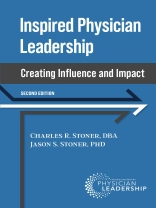Physicians have plenty of good ideas, but many physician leaders fall short of expectations due to their inability to effectively understand and handle the complex interpersonal and political issues that lie at the heart of successful and thriving leadership. The transition from clinician to physician leader is huge, requiring a different set of assumptions, skills, and approaches.
Covering topics like The Nature of Leadership and The Dynamics of Dialogue, to The Transition from Doer to Leader, Inspired Physician Leadership: Creating Influence and Impact, 2nd Edition is based in research and presented with applicable clarity to address the critical interpersonal skills necessary to promote influence, motivation, and needed change. Within it, physicians will find both grounded theory and practical tools to aid them in taking up the mantle of leadership.
How does this book give you an advantage?
By design, this book emphasizes established peer-reviewed research and current best practices as its foundation. However, the presentation and style are both engaging and application oriented. Readers will acquire specific skills that can be used immediately. Further, the book is rich with examples – all drawn from actual situations with physician leaders addressing their leadership issues. Here are just some of the topics the authors discuss in detail:
- The Need for Physician Leadership
- The Nature of Leadership
- The Transition from Doer to Leader
- The Transition from Technical Skills to Interpersonal Skills
- Intelligence and Action-Orientation
- The Quest for Interpersonal Trust
- Helping Build Confidence in Others
- Leaders Are Builders of Significance
- Emotional Intelligence
- Reciprocal Understanding
- The Dynamics of Engaged Listening
- Resolving or Managing Conflict
- The Behaviors of Respectful Conflict Encounters
- The Power of Pre-suasion
- The Keys to Principled Negotiation
- Building a Motivating Culture
- Ongoing Communication
If you’re a physician, you seek ideas that are grounded in research and theory. However, with time being a scarce resource, you’ll benefit even more from practical applications that can be added to your toolbox. This book strives to accomplish both aims.
Tabela de Conteúdo
Chapter 1: A New World: The Case for Physician Leadership
The Need for Physician Leadership
The Nature of Leadership
The Differential Impact of Leadership
The Physician Leader
Leaders as Trailblazers
Chapter 2: Transitions: The Challenges of the Physician-Leader Interplay
Why Lead?
Key Transitions
Strengths and Vulnerabilities
Chapter 3: Foundations: The Underpinnings of Thriving Physician Leadership
Character and Leadership
The Quest for Interpersonal Trust
What Is Trust?
Building Trust
Breaches of Trust
Self-Confidence
The Imposter Syndrome
Helping Build Confidence in Others
Chapter 4: Tone: The Significance of the Interpersonal Factor
Leadership and Interpersonal Tone
Leaders Are Builders of Significance
Humility and Warmth
The Case for Justice and Procedural Justice
Action Based in Respect
Emotional Intelligence
Emotional Self-Awareness
Emotion Regulation
Relational Intelligence
Chapter 5: Dialogue: Communicating for Understanding
Reciprocal Understanding
The Logic of Engaged Listening
The Dynamics of Engaged Listening
Expansive Questioning and Humble Inquiry
Conflicting Messages
The Dynamics of Dialogue
Chapter 6: Conflict: The Power of Respectful Conflict Encounters
The Upside of Conflict; The Downside
Resolving or Managing Conflict
The Structure of Interpersonal Conflict
The Behaviors of Respectful Conflict Encounters
The Respectful Conflict Encounter
Leadership in the Face of Tension
Dealing with Difficult and Problem People
Chapter 7: Influence: The Path of Impact
The Case for Rational Persuasion
The Power of Pre-suasion
Understanding and Touching Others’ Needs
The Reasons Behind the Request
Strategies of Influence
Presenting the Message
Executive Presence
Chapter 8: Politics: Finesse and Action
The Reality of Organizational Politics
Power Fundamentals
Silos, Suboptimization, and Self-Centric Bias
Using Political Tactics
The Keys to Principled Negotiation
Chapter 9: Motivation: Building Performance through People
Need Theory and Applications
The Power of Intrinsic Motivation
Physician Motivators
Common Contemporary Needs and Motivators
Equity Theory
Expectancy Theory
Goal Setting Theory
The Psychology of Flow
Generational Complexities
Building a Motivating Culture
Chapter 10: Change: A Future of Opportunity
The Behavioral Dynamics of Change
Why: Building the Compelling Case for Change
What: Setting the Direction
Personal Impact: Understanding and Managing Disruptions
Ongoing Communication
Giving Voice to Resistance
Capacity Enhancement
Accessibility
Reinforce Early Successes
A Mindset of Change
Chapter 11: Beginnings: Assuming the Mantle of Leadership
Hit the Ground Running
Patience
Empathic Clarity
Appropriate Assertiveness
Delegation
Running Meetings
The Boss Is Stepping Down but Is Not Ready to Let Go
The Friendship Dilemma
Sobre o autor
Jason S. Stoner, Ph D, is associate professor of management at Ohio University. Dr. Stoner earned his bachelor’s and master’s degrees from Bradley University and his Ph D from Florida State University. His research interests primarily focus on individual differences influencing reactions to workplace stressors. Dr. Stoner’s research has been published in Human Relations, Human Resource Management Review, Leadership Quarterly, Journal of Occupational Health Psychology, and Journal of Vocational Behavior.












